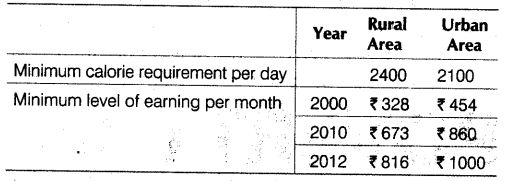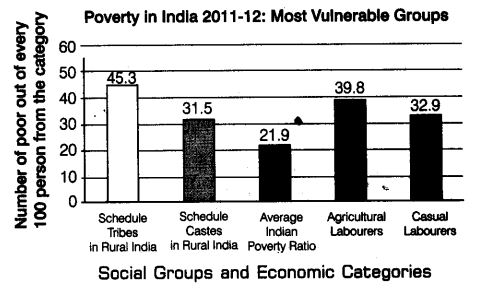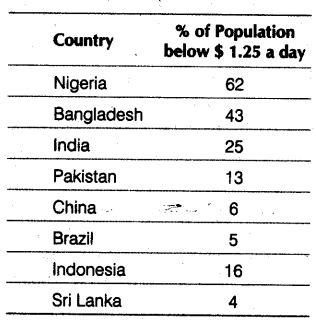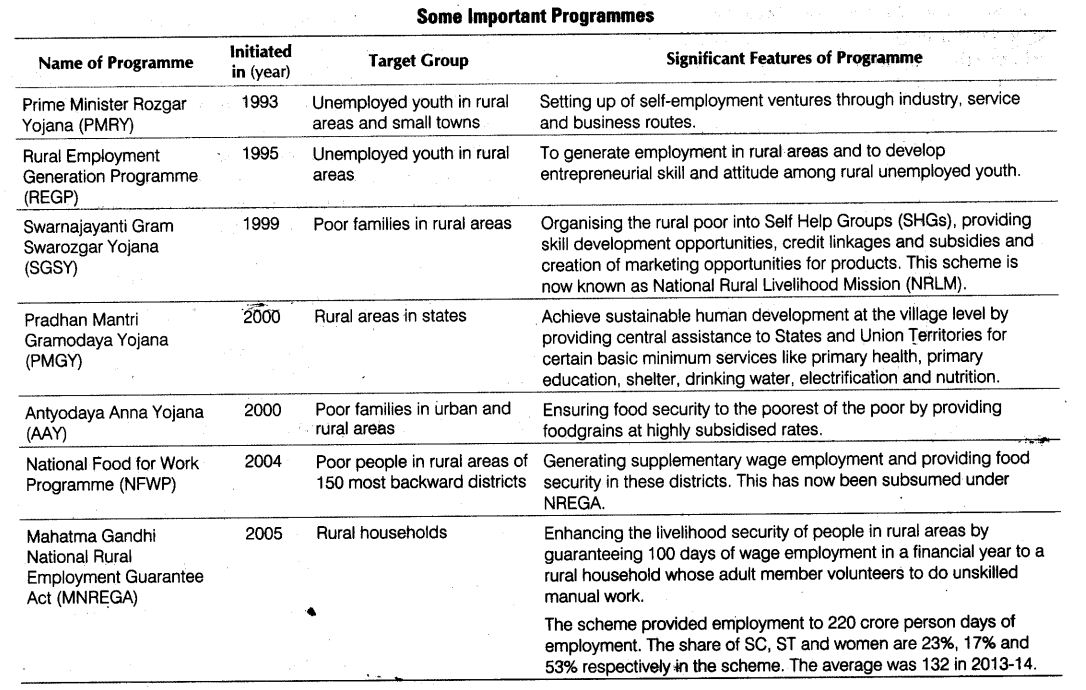Notes For All Chapters Economics Class 9 CBSE
Poverty is the most difficult challenge faced by independent India. Poverty is a condition in which a person lacks the financial resources and essentials things to enjoy minimum standards of life. Poor people can be landless labourers in villages, jhuggi and slum dwellers in cities and towns, daily wage workers at construction sites, child , workers in dhabas or even beggars. India has the largest single concentration of the poor in the world, where every fourth person is poor.
Two Typical Cases Of Poverty
The following two cases show the many dimensions of poverty, including lack of proper food, shelter, healthcare, education as well as clean water and sanitation. They also show lack of a regular means of livelihood.
(i) Urban Case
Ram Saran is a daily wage labourer in a flour mill near Ranchi in Jharkhand. He earns around Rs. 1500 per month when employed. He supports his family of 6 persons, besides sending some money to his elderly parents. His wife and son also work, but none of his 4 children can attend school. The family lives in a one-room rented house on the outer areas of the city; The children are undernourished, have very few clothes or footwear and no access to healthcare.
(ii) Rural Case
Lakha Singh is a landless labourer in a small village near Meerut in Uttar Pradesh. By doing odd jobs for farmers, he earns Rs. 50 per day. Sometimes, he gets some foodgrain or other items instead of cash. He is not literate and his family of 8 people lives in a kuchha hut near the edge of the village. They have no access to healthcare, cannot afford new clothes or even soap or oil.
Poverty Analysis by Social Scientists
Social scientists, analyze poverty from many aspects besides levels of income and consumption.
These aspects are
- Poor level of literacy
- Malnutrition leading to poor resistance to disease
- Lack of access to healthcare
- Lack of job opportunities
- Lack of access to sanitation and safe drinking water and so on.
Indicators for Poverty
The most commonly used indicators for poverty analysis are social exclusion and vulnerability.
Social Exclusion
A social exclusion means living in a poor surrounding with poor people, excluded from enjoying Social equality of better off people in the better surrounding. Social exclusion can be a cause as well as a result of poverty which leads to exclusion of individuals or groups from facilities, benefits and opportunities that others enjoy.
In India, the caste system is based on social exclusion. People belonging to certain caste were prevented from enjoying equal facilities, benefits and opportunities. This caused more poverty than the lower income.
Vulnerability
Vulnerability to poverty is a measure, which describes the greater probability of certain communities e.g. members of a backward caste or individuals e.g. widow, physically handicapped person of becoming or remaining poor in the coming time.
Vulnerability is determined by various options available to different communities in terms of assets, education, job, health, etc and analyse their ability to face various risks like natural disasters. The group which face greater risk at the time of natural calamity are called vulnerable groups.
Poverty Line
Poverty line is an imaginary line used by any country to determine its poverty. It is considered appropriate by a country according to its existing social norms. It varies from time to time, place to place and country to country.
The most common method of determining poverty is income or consumption levels i.e. people will be considered poor if their income or consumption level falls below a given ‘minimum level’ (poverty line) necessary to fulfil the basic needs.
Poverty Line Estimation in India
In India, a subsistence level or minimum level of food requirement (as determined by its calorific value), clothing, footwear, fuel, lighting,-educational and medical requirements, etc are determined for estimating the poverty line. Since ih rural and urban areas, the nature of work and the prices of goods are different, the calorific requirement and expenditure per capita are also different.
Poverty line defined by the government as follows
The money value required for buying these calorie requirements (given in the last column) in terms of foodgrains and other items is revised periodically based on rise in prices of these goods. In urban areas, the prices of essential items is higher when compared to the rural areas and so, the poverty line is higher despite having low calorific requirement per day.
Organisations Involved in Estimating Poverty Line
Surveys for determining poverty line are carried out by the National Sample Survey Organisation (NSSO). It is an organisation under the Ministry of Statistics and Programme Implementation of the Government of India. It conducts surveys at the interval of 5 years. It is the largest organisation in India conducting regular socio-economic surveys. It was established in 1950.
For determining the poverty line in various countries and for their comparison, international organisations like the World Bank use a uniform standard method. As per this method, the poverty line is level of minimum availability of the equivalent of $1 per person per day.
Poverty Trends In India
There is a decline in poverty ratios in India from about 45% in 1994 to 21.9% in 2012. If the trend of declining poverty ratios in India continues at this rate, then the poverty line may reduce 20% in the next few years.
Group Vulnerable to Poverty
Poverty among social groups and economic categories varies widely in India. Social vulnerable groups are the households of the Scheduled Castes (SCs) and Scheduled Tribes (STs). Economically vulnerable groups comprise rural landless labour households and urban casual labour households.
However, during the last few years, all these groups except the Scheduled Tribes group, have witnessed a decline in poverty.
In the year 2011-12, the proportions (as determined by NSSO) were as given below
Source Reports of Employment and Unemployment among Social Groups in India NSSO. Ministry of Statistics and Programme Implementation, Government of India.
There is a great difference within poor families. It is observed that female infants, women and elderly members are not given equal access to resources available to the family. So, they are also called poorest of the poor.
Story of Sivaraman
The family of Sivaraman, a rural landless labourer has been cited as an example of such a family. There are 8 members in the family and both he and the wife work. His children do not attend school due to poverty. Only his son gets milk sometimes and they find difficulty in managing even two meals in a day.
The story portays the sufferings of Sivaraman who works as an agricultural labourer, that too for just 5-6 months in a year. The sufferings and inequality within the family for women and children »are even more. Girls are not sent to school and not even given milk to drink, while the youngest child, who is a son gets milk to drink sometimes and his parents also plan for his education.
Inter-State Disparities
The proportion of poor people is not the same in every state. Recent estimates show while the all India HCR was 21.9% in 2011-12, states like Madhya Pradesh, Assam, Uttar Pradesh, Bihar and Orissa had all India poverty level.
Bihar and Odisha continue to be the two poorest states with poverty ratios of 33.7% and 37.6% respectively. Alongwith rural poverty, urban poverty is also high in Odisha, Madhya Pradesh, Bihar and Uttar Pradesh.
In states like Kerala, Jammu and Kashmir, Andhra Pradesh, Tamil Nadu, Gujarat, West Bengal, there is a significant decline in poverty. The states successful in reducing poverty have adopted different methods for doing so.
Some examples are
- Punjab and Haryana had high agricultural growth rates due to the effects of the Green Revolution.
- Kerala has developed its human resources by investing more in education.
- West Bengal has reduced poverty by implementing land reforms.
- Public distribution of foodgrains at subsidised prices in Andhra Pradesh and Tamil Nadu has helped in poverty reduction.
- Jammu and Kashmir have generated wide-ranging economic activities all across the state and converted potential in various sectors into employment opportunities.
Global Poverty Scenario
Although extreme economic poverty has reduced in the world from 43% in 1990 to 22% in 2008 (as per the World Bank), still there are vast regional differences. These are stated below
The proportion of people living under poverty in different countries is defined by the international poverty line (means population below $1 a day).
In South-East Asia and China, there is a decline in poverty due to rapid economic growth and massive investment in human resource development.
In Latin America and the Caribbean, the poverty ratio has not changed significantly since 1981.
In Sub-Saharan Africa, poverty has increased since 1981 due to successive droughts and other reasons. However, it declined from 51% in 1981 to 47% in 2008.
Economic Growth It is a term which defines an increase in real output of a country.
The Millennium Development Goals of the United Nations (formulated in the year 2000) call for reducing the proportion of people living on less than $1 a day to half the 1990 level by 2015.
Causes of Poverty
Poverty continues in India for a variety of reasons.
These are
- Historically, there was a low level of economic development under the British colonial administration prior to 1947. They discouraged traditional handicrafts and also industrial development, reducing job opportunities and income growth.
- The low level of economic development persisted for many years after independence and due to population increase, per capita income growth was low, increasing poverty.
- The Green Revolution improved opportunities in agriculture, only in certain areas of the country.
- The growth in the population increased the number of job seekers, who had to be content with low paying jobs in urban areas, leading to poverty spreading to towns and cities.
- Sociocultural (i.e. traditions) and economic factors lead to extra expenditure, which ultimately increases poverty.
- There is an unequal distribution of land and other resources, that is why there are large income inequalities also.
- Land reforms have not been properly implemented and lack of adequate land resources is also a reason for many people to be poor.
- Small farmers borrow money for seeds, fertilisers and pesticides, etc and later on fail to pay landing in debt trap. This high level of indebtedness is both the cause and effect of poverty.
Anti-Poverty Measures
Removal of poverty has been one of the major objectives of Indian developmental strategy.
The current anti-poverty strategy of the government is based on the following two objectives
(i) Promotion of Economic Growth
The government has promoted economic growth during the last few years. Economic growth was low till the 1980s but has increased significantly since then, causing significant poverty reduction. The high economic growth helps in a significant reduction of poverty. There is strong linkage between economic growth and poverty reduction. Economic growth widens opportunities and provides the resources needed to invest in human development.
High economic growth encourages people to send their children (including the girl child) to school with hope of better economic returns from investing in education.
The poof may not take direct advantage of economic growth. Due to lack of growth in the agricultural sector, the large number of people remain poor in rural areas.
(ii) Targeted Anti-Poverty Programmes
The government introduced targeted anti-poverty programmes starting from 1990. The results of these programmes have been mixed due to lack of proper implementation and improper targeting. Also, some schemes overlap others. Thus, the benefits of these schemes are not fully reaching the deserving poor.
So, now the government is emphasising more on proper monitoring of all these programmes.
Millennium Development Goals These are eight international development goals that were officially established following the Millennium Summit of the United Nations in 2000, following the adoption of the United Nations Millennium Declaration. One of these was to reduce by 50% the proportion of people living on less than US $1 a day by the year 2015.
The Challenges to Poverty Reduction
Poverty reduction is still a major challenge in India, due to the wide differences between regions as well as rural and urban areas. Further, poverty should include not only the matter of the adequate amount of food but other factors like education, healthcare, shelter, job security, gender, equality, dignity and so on.
These give us the concept of human poverty. Poverty reduction is expected to be lower in the next 10-15 years.
In addition to anti-poverty measures, the government should focus on the following to reduce poverty.
- Higher economic growth.
- Universal free elementary education.
- The decrease in population growth.
- Empowerment of women and weaker sections.
Summary
The most difficult challenge faced by independent India is poverty.
India has the largest single concentration of the poor in the world, where every fourth person is poor.
Social scientists analysis poverty from many aspect besides level of income and consumption.
These aspects include poor level of literacy, lack of job opportunities etc.
Social exclusion aneb* vulnerability are the most commonly used indicators for poverty analysis.
The poverty line is an imaginary line used by any country to determine is poverty. It varies time to time, place to place and country to country.
The most common method of determining poverty is income or consumption levels.
The calorific requirement and expenditure per capita are different for urban and rural areas.
Surveys for determining poverty lines are carried out by the National Sample Survey Organisation (NSSO).
The organisation is under the Ministry of statistics and programme implementation of the Government of India.
Poverty among social groups and economic categories varies widely in India.
Female infants, women and elderly member are not given equal access to resources available to the family.
Bihar and Odisha continue to be the two poorest states with poverty ratios of 33.7% and 37.6% respectively.
In states like Kerala, Andhra Pradesh, Gujarat, there is significant decline in poverty.
The proportion of people living under poverty in different countries is defined by the international poverty line i.e. population below $ 1 a day.
There is decline in poverty in South-East Asia and China due to rapid economic growth and massive investment in human resource development.
The Millenium Development Goals of the United Nations formulated in 2000, call for reducing the proportion of people living on less than $ 1 a day to half the 1990 level by 2015.
There are many causes for the prevalence of poverty in India like unemployment, low economic development and income inequalities.
Removal of poverty has been one of the major objectives of Indian developmental strategy.
There is a strong linkage between economic growth and poverty reduction.
The Government of India introduced targeted anti-poverty programmes starting from 1990.
Poverty reduction is still a major challenge in India, due to the wide differences between regions as well as rural and urban areas.




Leave a Reply